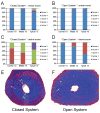Effect of vapor lock on root canal debridement by using a side-vented needle for positive-pressure irrigant delivery
- PMID: 20307757
- PMCID: PMC2844877
- DOI: 10.1016/j.joen.2009.11.022
Effect of vapor lock on root canal debridement by using a side-vented needle for positive-pressure irrigant delivery
Abstract
Introduction: This study examined the effect of vapor lock on canal debridement efficacy by testing the null hypothesis that there is no difference between a "closed" and an "open" system design in smear layer and debris removal by using a side-vented needle for irrigant delivery.
Methods: Roots in the closed system were sealed with hot glue and embedded in polyvinylsiloxane to restrict fluid flow through the apical foramen during cleaning and shaping. For the open system, the apical foramen was enlarged and connected to the external environment via a channel within the polyvinylsiloxane to permit unrestricted fluid flow. Smear and debris scores were evaluated by using scanning electron microscopy and analyzed by using Cochran-Mantel-Haenszel statistic.
Results: No difference in smear scores was detected between the 2 systems at all canal levels. Significant differences in debris scores between the 2 systems were found at each canal level: coronal (P < .001), middle (P < .001), and apical (P < .001).
Conclusions: The null hypothesis was rejected; presence of an apical vapor lock effect adversely affects debridement efficacy. Thus, studies with unspecified or questionable mechanisms to restrict fluid flow through the apical foramen have to be interpreted with caution.
Copyright (c) 2010 American Association of Endodontists. Published by Elsevier Inc. All rights reserved.
Figures



References
-
- Schilder H. Cleaning and shaping the root canal. Dent Clin North Am. 1974;18:269–96. - PubMed
-
- Sjögren U, Figdor D, Persson S, Sundqvist G. Influence of infection at the time of root filling on the outcome of endodontic treatment of teeth with apical periodontitis. Int Endod J. 1997;30:297–306. - PubMed
-
- Nair PN. Pathogenesis of apical periodontitis and the causes of endodontic failures. Crit Rev Oral Biol Med. 2004;15:348–81. - PubMed
-
- Haapasalo M, Endal U, Zandi H, Coil JM. Eradication of endodontic infection by instrumentation and irrigation solutions. Endod Topics. 2005;10:77–102.
-
- Moser JB, Heuer MA. Forces and efficacy in endodontic irrigation systems. Oral Surg Oral Med Oral Pathol. 1982;53:425–8. - PubMed
Publication types
MeSH terms
Substances
Grants and funding
LinkOut - more resources
Full Text Sources

